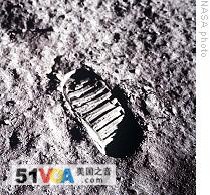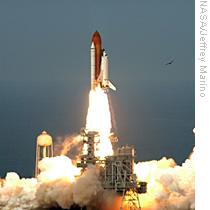Houston
17 July 2009
 |
| In this July 20, 1969 file photo, Astronaut Edwin E. 'Buzz' Aldrin Jr. poses for photograph beside US flag deployed on moon during Apollo 11 mission |
Thousands of people come to the Johnson Space Center in Houston every week to look at some of the rockets and equipment developed back in the 1960s for NASA missions. For many people, those were the glory years, when the Apollo astronauts walked on the moon. But John Connolly, who works with NASA's new lunar project based at the Johnson Space Center, sees even greater things ahead.
"There is a new generation of engineers and scientists now at NASA who are eager to get back to the moon to find a lot of those things that Apollo uncovered and that we are finally able to get back to the moon to explore," he said.
Engines are firing in tests already under way for the powerful new Ares rockets NASA hopes to use in its Constellation Program, which involves returning to the moon within ten years to establish bases. The missions will count on a much larger lunar landing vehicle and mechanical rovers that can transport both astronauts and equipment around the surface of the orb.
John Connolly says there is now evidence that there may be water, in the form of ice, at the moon's poles. In addition, he says study of material brought back from the moon's surface four decades ago shows the availability of oxygen that perhaps can be extracted from the rocks using solar energy.
 |
| A close-up view of astronaut Buzz Aldrin's bootprint in the lunar soil, photographed with the 70mm lunar surface camera during Apollo 11's sojourn on the moon |
But such plans, ambitious as they are, disappoint many space enthusiasts, including the second man to step foot on the moon, in the Apollo 11 mission, Edwin "Buzz" Aldrin. At a recent appearance here in Houston, he expressed skepticism of the plan that will take another 10 years just to get back to where he was 40 years ago.
"Surely there is something not quite right. Maybe we are implementing this wonderful vision in not so smart a way," he said.
 |
| Liftoff of space shuttle 'Endeavour' from Launch Pad 39A at NASA's Kennedy Space Center in Florida |
Business experts also wonder how a government agency like NASA will fare at a time when the U.S. budget deficit has reached record levels. Chris Bronk, a technology analyst at Rice University, and Troy Gattis, a computer systems architect with Houston's Open Teams software company, recently wrote an editorial suggesting NASA needs to be more like an innovative private company.
Chris Bronk says government funding may fall short in the years ahead.
"When you look at the manned space mission goals of getting back to the moon, getting to Mars, there is a mandate there that does not equate to the resources that are already provided," he said.
The answer, says Gattis, is innovation.
"Given the realistic government budgets going forward, if NASA is going to accomplish these great inspirational things, they are going to need this level of innovation that makes space travel become cheaper, easier, faster on a regular basis," he explained.
NASA officials say they are aware of the budget restraints. John Connolly says the agency is trying to carry out the mandates from the president and U.S. Congress relying on expertise from within and from experts around the world.
"It starts internally at NASA. We have a lot of people who are really smart and who have thought about it for many, many years, like myself. So that is where it starts, but it quickly grows to be a project where we get the input from lots and lots of smart people out there," he said.
NASA hopes to do a manned test of the Orion launch vehicle by 2015, with the goal of sending a mission to the moon by the year 2020. The Orion, which is to be flown into space on the new Ares rocket, includes a launch abort system that will allow the crew module to separate and return to earth in case of a malfunction. The Altair lunar landing craft is being developed to carry up to four astronauts to the moon's surface and allow them to stay there for up to a week.